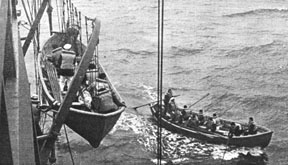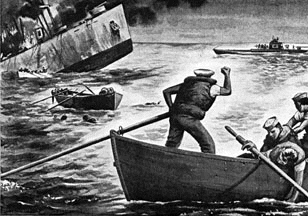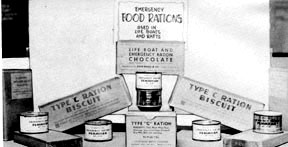SS Richard Hovey: a Tale of Japanese Atrocities and Survival
by Bruce Felknor
The Liberty ship SS Richard Hovey, torpedoed and sunk in the Arabian Sea in March 1944, is probably best remembered for the ingenuity of her junior assistant engineer, Arthur Drechsler.
In a shot-up lifeboat, he devised a tiller to steer it and a still to convert sea water into drinking water. As a result, though one man died of injuries, he and 37 shipmates reached safety after 17 days under oar and sail beneath the tropic sun in a 31-man boat. These feats earned him the Merchant Marine Distinguished Service Medal.
All told, 63 of the 71 on board the Hovey survived, but a blood-curdling story lies behind the survival of anybody at all from that lucky and luckless crew.
The Hovey sailed from Bombay on March 27, bound for home via the Suez and the Mediterranean, with a merchant crew of 41, Naval Armed Guard detail of 28, an Army cargo officer, and a consular passenger. A radio alert the day after sailing reported a periscope sighting in the area and Captain Hans Thorsen ordered a zigzag course.
At dusk the order came to deploy the torpedo nets and the nets were streamed about 2100. Every man on watch strained his senses to spot a periscope, but saw only one lone dhow.
Liberty shipTorpedoed
The next afternoon at 1615, the gunnery officer, Lt. (jg) Harry Chester Goudy was napping in his cabin when, nets or not, one torpedo exploded in the engine room and a second in No. 4 hold. He dashed to his battle station on the bridge as the general alarm and the gunners' alarm were sounding.The 3 men on engine room watch were killed instantly.A third torpedo hit at No.3 hold, and the ship began to buckle amidships One of the gun crew, S1c Philip Fittipaldi, in position at the stern gun, had been critically burned in the first explosion, which sent flaming cargo into the air and showering down onto the deck. Lifeboat No.3 was demolished but the other three boats were intact. In the radio shack, Radio Officer Mathers was able to get out distress calls on several frequencies, but received no acknowledgement.
After ordering abandon ship and sinking his confidential papers, the skipper joined the Chief Mate in supervising the loading of the boats. Boat No.4 with 15 men was lowered first, and Chief Mate Richard Evans later took charge of it. Then came boat No.2, with the badly burned Fittipaldi and 16 others, with the boatswain in command. Boat No.1, under Second Mate Turner, was launched last. The captain joined it.
Two rafts on the port side were released. Ten of the Armed Guard clambered on one of them, and were taken in tow by the Chief Mate's boat, No.4. The rest of the gunners, including Lt. Goudy, the last man off the ship, made it into the other raft. Boat No.1 took it under tow.
Not until the boats were in the water did anyone see so much as a periscope. It was ahead of the ship, moving back and forth.. It surfaced on the port side, and commenced firing on the flaming Hovey with a big deck gun, a 5- or 6-incher, Goudy estimated. The lifeboats and rafts lay between the sub and the ship during this shelling.

Launching lifeboatsAttack on the Lifeboats
Every now and then," Goudy recalled, "a shell would whiz over our heads, and although we did not realize it at the time, it is apparent they were firing at us. We thought it was a ricochet shot coming in our direction."The sub came closer and began firing 20 mms and automatic rifles at boat No.2. The men jumped overboard on the far side to hide. On came the sub, ramming the lifeboat, capsizing, and partially sinking it. The Captain's boat was its next target. The men slipped overboard and tried to remain out of sight.
"As the submarine was within a few feet of us," Goudy wrote, "we could definitely determine that the men, who were lined up on its deck as though they were on parade, were Japanese. They were in khaki uniforms and khaki caps. They were laughing and seemed to get quite a bit of sport out of our predicament." One of the Japanese recorded the entire scene with a movie camera.
Japanese sailor films attack, while others fire gun at lifeboats and ship
After the sub shot up boat No.4, it turned back toward boats No.2 and 1, with the Japanese commanding officer calling from the deck in clear English, "Where is your captain? We want your skipper."
Finally Captain Thorsen stood up in boat No.1, joined by Second Mate Turner, a fireman-watertender named Simms, and an AB, Bill Margetto. They were taken aboard the submarine and not seen again by the crew. Eventually they were repatriated.
A Japanese crewman boarded boat No.1, smashed its radio, and the sub towed the lifeboat away, disappearing into the gathering night. The submarine was the Kusaka, I-26, sunk east of the Philippines eight months later.

MAST magazine, September 1944, depiction of attack on Hovey Lifeboat No.2, Gunnery Officer, Lt. (jg) Harry Goudy
During all this, the boats and rafts had drifted apart. Boat No.2 was righted and took on 39 survivors who were divided between the badly damaged lifeboat, designed for a maximum of 31, and two rafts. Amazingly enough, for all the Japanese fire on the boats and rafts, only one man was hit: the deck engineer, whose name was Burns. He and the burned Fittipaldi were among the 39.In the morning, the bullet and shell holes in the lifeboat were repaired from kits aboard the boat, and an oar was improvised in place of the smashed tiller. Boat No.2, with two rafts in tow, and with three shifts of men rowing, set off on what would be a 17-day ordeal.
Both water tanks had been damaged but the water in one was still drinkable. That gave the survivors just enough time for Arthur Drechsler's remarkable contrivance of a fresh water still. Drechsler built his still in one raft and the other was dismantled for firewood. [A summary of the still's construction appears in Drechsler's citation for the Merchant Marine Distinguished Service medal, and a more detailed version is in my current book, The U.S. Merchant Marine at War, 1775-1945, pp. 319-21.]
Burns's shrapnel wound healed rather quickly. The severe burns covering Fittipaldi's head and upper body were treated, but the man was in agony for 13 days. He died on April 10, and was wrapped, prayed over, and buried at sea. There were sharks in the area; Lt. Goudy told the men to row and not look back.
As food supplies dwindled, the men were able to catch fish by netting and harpooning. There was enough to keep them alive, but all were growing weaker.
Lifeboat rationsAbout 0230 on April 14, GM3c William Kuchling spotted a ship. A parachute flare and flashlight signals by two Navy signalmen soon brought the British Liberty ship SS Samuta alongside. Their ordeal was over. The Samuta landed the men at Cochin in southwest India, where they were hospitalized and repatriated.
Lifeboat No.4, Chief Mate Evans
From the vantage point of the men hiding in the water behind motor lifeboat No.4, it was perfectly apparent that the submarine's ramming, shelling, and machine-gunning of boat No.2 had killed all aboard.When the sub did not return to his boat, Evans decided darkness made an escape attempt possible. The 10 Navy men from the raft and 14 merchant crew crawled on board boat No.4 with Evans.
The Mate wanted to look for the other raft, but feared another encounter with the submarine. Moreover, with more than 50 holes in its hull, he feared that any additional occupants would imperil the survival chances of the 25 already in the boat.
Evans discussed the dilemma with the officers and men aboard, and settled on putting food and medical supplies on the empty raft and leaving it behind. In fact, the overcrowded No.2 boat found the raft and its passengers gratefully used its food and first aid gear.
The Mate's boat progressed slowly, alternately under oar and under power, at low speed to conserve fuel. After three days, Daniel Bartholomew sighted the SS Samcalia, a British Liberty, which landed them at Karachi, India (now Pakistan).
Goudy Makes Official Complaint
A final irony remained, strikingly like the theme of the classic Japanese movie Rashomon a few years later. It is a tale of conflicting perceptions of the Chief Mate's actions after the attack.Distance, darkness, and the maneuvers and gunfire of the submarine made it impossible for Lt. Goudy and Chief Officer Evans to see one another. But when Goudy's oared boat could not locate Evans's powered boat, Goudy concluded that Evans -- with only 25 men -- had made off under power without trying to find the 39 survivors crowded into the gunnery officer's boat. As we know, Evans concluded that Goudy's entire group had been killed, and that even a few more passengers would swamp his own leaking craft.
After much reflection, Goudy filed a complaint against Evans with the Coast Guard, which licenses Merchant Marine officers. He claimed the Chief Mate acted improperly by leaving the scene of the torpedoing so quickly, and not staying to search for survivors. One man in the Mate's boat, utility man John DeSoiza, agreed and also felt the Chief Mate should have run the lifeboat engine at full speed.
The examining officer, Lt. R. K. Gould, USCGR, weighed all the testimony, including the Chief Mate's side of the story, and issued a finding of fact rejecting Goudy's charge. He pointed out that the gunnery officer was unaware of Evans's search activity and his foresight in stocking the raft which helped Goudy's boat survive.
"The facts . . . do not support the complaint," he wrote, "Instead, it appears that Evans conducted himself in a most creditable manner in all of these circumstances," and that his actions helped save lives of the men in both boats.
I would like to contact survivors of the Liberty ship SS Richard Hovey to followup on this article. Bruce FelknorSources for this account are in the National Archives at College Park, MD, in Record Group 38, under Summary of Statements of Survivors of SS Richard Hovey.
Illustrations from:
United States Maritime Service official photograph
He's In the Merchant Marine Now, John Scott Douglas and Albert Salz, New York: Robert M. McBride and Co.,1943
United States Maritime Service Training Manual, War Shipping Administration Training Organization, published for United States Maritime Service by Cornell Maritime Press, 1944
MAST Magazine, United States Maritime Service division of War Shipping Administration, September 1944, Brooklyn, New YorkBruce Felknor's Home Page
Distinguished Service Medal Citations
Home6/21/00
www.USMM.org ©1998 - 2000 Bruce Felknor and. You may quote small portions of material on this website as long as you cite American Merchant Marine at War, www.usmm.org, as the source. You may not use more than a few paragraphs without permission. If you see substantial portions of any page from this website on the Internet or in published material please notify usmm.org @ comcast.net

